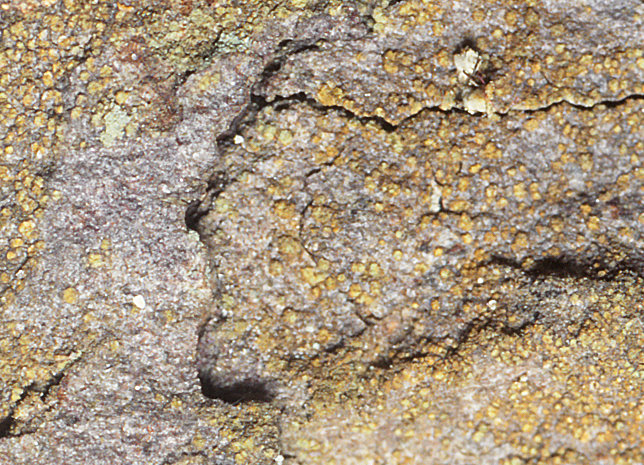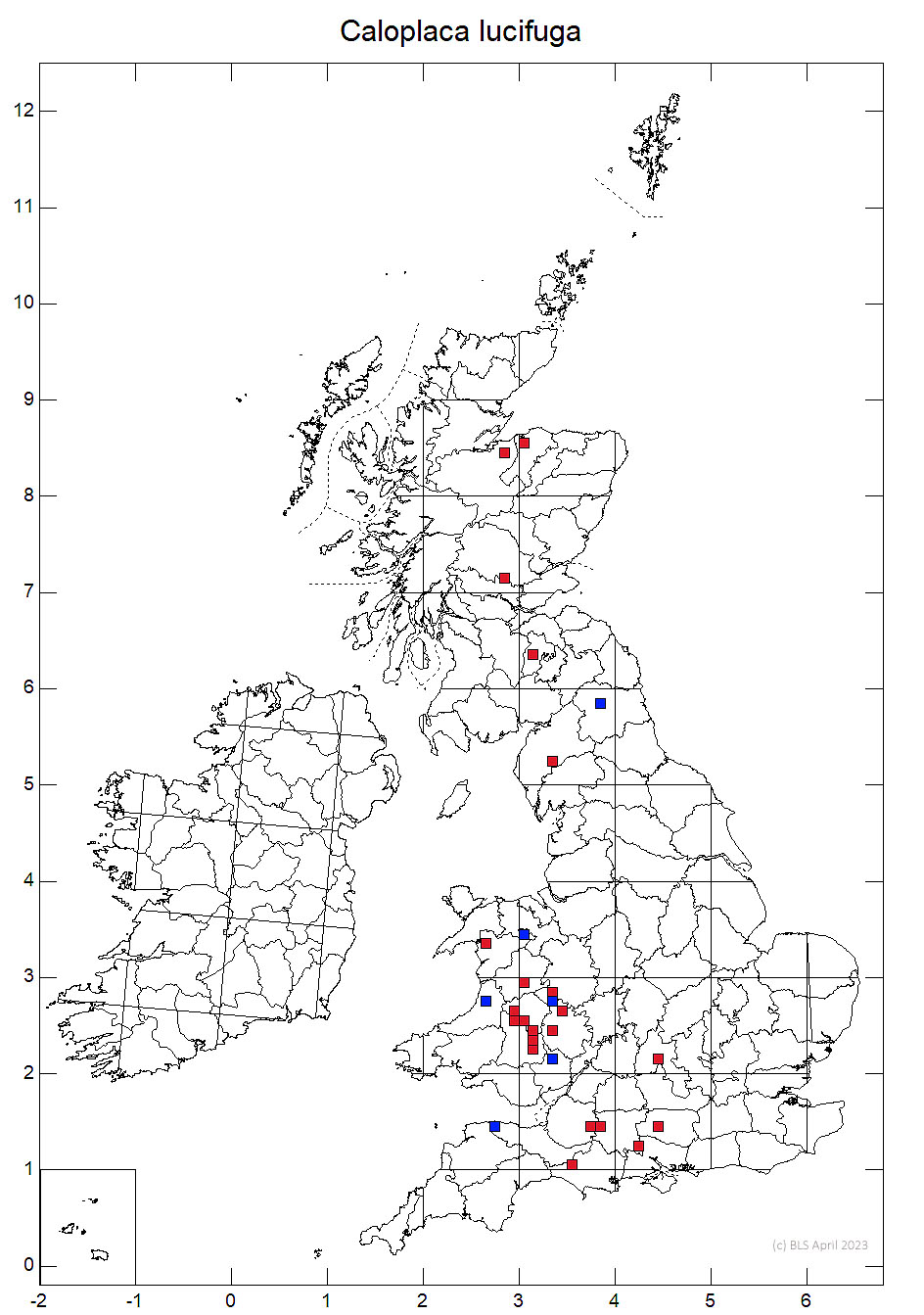Found on bark with inconspicuous thallus - immersed in the bark or as a thin grey film. Soralia are numerous and very crowded, often contiguous, pale yellow to dirty yellow-orange-brown, flat and ulcer-like bcoming convex and rounded; soredia farinose (floury). Apothecia are unknown. Chemistry: Thallus K-, soralia K+ purple Ray Woods says: This is a very obscure species first described in 1988. It appears as a khaki/gold smear that is K+purple. I have had immense difficulty refinding it in a number of sites.

Photo: V. Alstrup
Caloplaca ulcerosa and C. obscurella are similar but have more scattered and discrete soralia which are K-.
In crevices of rough bark of old trees, especially oak, in wood-pasture. In the Welsh Marches it is found deep down in crevices in the bark of ancient oak trees usually in well-lit situations. The old deer parks and ornamental parklands of the March suit it well. (RGW)
W. Europe. Herefordshire, N. Devon, Northumberland, S. Scotland. Mid-Wales. Its world headquarters appears to be the Welsh Marches. (RGW)
| Location | Grid Reference | Last Rec'd | Recorders(s) | SSSI |
| Brecknock: South of Trefeinion, Llangorse | SO13372946 | 2003 | R.G. Woods | No |
| Brecknock: Pwll-y-Wrach, valley S of Talgarth | SO163325 | 1989 | R.G. Woods | Yes |
|
Brecknock: North of Llysdinam |
SN998599 |
2009 |
R.G. Woods |
Yes |
| Brecknock: Cwm yr Esgob, Carngafallt | SN9338164915 | 2011 | R.G. Woods, I. Blatchley & A.O. Orange | |
| Ceredigion: Nanteos Mansion Park | SN616780 | 1992 | R.G. Woods | No |
| Ceredigion: Trawscoed | SN670733 | 1996 | S.P. Chambers | No |
| Meirionydd: Corwen Rug | SJ058445 | 1996 | A.O. Orange | No |
| Radnor: Maesllwch - Castle Park | SO1640 | 2003 | S.P. Chambers | No |
| Radnor: N of Pencerreg | SO044540 | 1997 | R.G. Woods | No |
The following notes are from Ray Woods:
South of Trefeinion, Llangorse - on an ancient oak tree in lane bank.
North of Llysdinam - on an ancient oak tree in pasture woodland.
Cwm yr Esgob, Carngafallt - on an ancient oak tree in crevices sheltered from direct rainfall amongst a group of ancient pollard oaks south of Elan Village on an RSPB reserve. Associated species in a 25cm square quadrat were Bacidia biatorina, Pyrrhospora quernea, a white undetermined crustose lichen and the moss Isothecium myosuroides.
The major threat is the collapse of the old tree. Where the trees are in pasture woodland the spreading of slurry and artificial fertilizers if directed over the trunks could smother or unacceptably eutrophicate the lichen. At Moccas park in Herefordshire, the site of the original discovery of the lichen in Britain, eutrophication is a significant problem and a search of the original oak tree beside the Lawn Pool recently failed to relocate it. The lane site site at Trefeinnon was subject to an unsual threat. The highways dept of the local authority chose the dry base of the old oak tree as a convenient dump for winter salt. Fortunately discovered in time before killing the oak the salt has now been placed downslope in a plastic box. However a resurvey of the tree here failed to rediscover the lichen as did a resurvey at nearby Pwllywrach. There is no obvious hypereutrophication problem in either of these two site though both are situated in an area of fairly intensively managed farmland. The Pwllywrach site may also have been subject to undue shading from adjacent holly trees.
- Monitor the habitat and species at sites, at least every 6 years, to ensure that owners and occupiers continue to be aware of the presence of this lichen and that management maintains and/or expands suitable well-lit mature and veteran native trees, paying special attention to threats from excessive shade cast by climbers and evergreen trees and shrubs, particularly invasive non-native species and inappropriate grazing levels, forestry operations or adjacent land uses. Ensure wayside trees are kept free of fertilizers, manure and slurry through the implimentation of agri-environment schemes and if necessary tree surgery is carried out to improve the stability of the tree and prolong its life without damaging the lichen.
- Promote further survey of potentially suitable trees and bring any newly discovered populations into the monitoring/management programme.
- Encourage the planting of new suitable wayside, hedgerow and parkland trees to provide additional habitat and the promotion of existing trees towards veteran status.
- Promote the protection of sites through entry into agrienvirenment schemes.
Coppins, B.J & Fletcher,A. (2001). Caloplaca lucifuga. Species account 1642/2001 in the Caloplaca fascicle of the Lichen Atlas of the British Isles produced by the British Lichen Society, London.
- Log in to post comments

